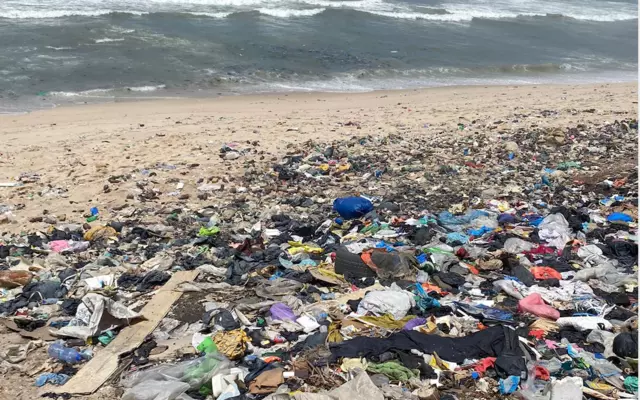
本日、数年前日本から撤退した Forever 21 が日本に再上陸するというニュースが発表されました。Fast Fashionの定番といえば、ユニクロ、GU、そして海外からのZARA, H&M, Forever 21ですね。私(代表Okadaです)は年齢的にFast Fashionは購入しなくなりましたが、日本にいてほぼ人と被らないForever 21がお気に入りだったので、閉店最終日は買いだめしに行った思い出があります。
さて、ニュースサイトから英語学習にうってつけの記事を厳選していく、多読向け教材シリーズ。
The New York Times, USA Today, Washington Post, Bloomberg, Newsweek といったニュース系の記事を読むことをルーティン化している代表Okadaです。ちなみにですが、知らない表現があれば、Macbook/iPhoneなどのデフォルトアプリの"Notes(メモ帳?!)"に日々追加しています。単語単位で抽出しても思い出せないことがあるため、基本的に記事の1センテンスをまるごと抜き出して書き溜めています。
さて今回は初登場のニュースサイトです。"THE WEEK" 。英語のニュースサイトの中では群を抜いて読みやすいニュースサイトですので、高校生1〜2年生でもチャレンジできるでしょう。
THE WEEK イギリスで1995年に生まれたかなり新しい週刊誌です。2001年からアメリカ版が開始され普及し始めました。今回ご紹介する記事はそのウェブ版にあたります。 THE WEEKの特徴は、他メディアが報じたニュース記事をサマライジング(要約)して、執筆者が読みやすいようにまとめ直してくれていることです。記事のいたるところに「New York Timesによれば」とか「Bloomberkが...って書いている」という表現が見つかります。 サクッと旬のニュースを確認でき、また、使用されている語彙レベルは高くないので初学者にもオススメです。Speed Reading(速読)、短めの旬な記事が集められているカテゴリーも設定されており、使い勝手がよいウェブサイトです。
Article (記事)
The real cost of fast fashion
-Buying cheap clothing has never been easier. But is there a greater price to pay?
https://theweek.com/feature/briefing/1016752/the-real-cost-of-fast-fashion
Number of Words
1040 words
黙読5m12s 音読6m30 で読み切れればスピードリーディングスキル(速読力)十分。
Text:本文(https://theweek.com/feature/briefing/1016752/the-real-cost-of-fast-fashion)
The real cost of fast fashion
-Buying cheap clothing has never been easier. But is there a greater price to pay?
The culture around fashion has transformed with the rise of social media, prompting many to buy new clothes often and for cheap. The problem is that we pay for these clothes in different ways, some of which are more detrimental than we realize. Here's everything you need to know about the concerning rise of fast fashion:
What is fast fashion?
Fast fashion refers to clothes that are designed quickly and cheaply to keep up with trends. Many of the most popular and readily accessible brands are fast fashion, including Zara, Forever 21, H&M, and Shein.
Historically, a trend cycle used to last approximately 20 years — meaning that in-fashion looks loop back around every two decades or so, reports NPR. The fashion life cycle rotates through five stages: introduction, increase, peak, decline, and obsolescence.
However, due to the rise of social media, and especially Tiktok, trends are starting to resurface faster in addition to dying faster. This is because social media encourages "microtrends," which are when an article or a particular piece of clothing becomes trendy rather than a larger genre, but then just as quickly falls out of fashion. This causes companies to quickly design and produce new pieces, just for them to soon become obsolete. Now, microtrends that used to last three to five years only last a few months.
The accelerated fashion life cycle has put pressure both on the environment as well as laborers who have to bear the brunt of the production turnarounds.
How does fast fashion impact the environment?
According to the UN Environment Programme, the fashion industry is the second highest for water consumption and makes up approximately eight 8 to 10 percent of global carbon emissions. Fashion production tends to average a 5 percent increase per year — however, even that much is likely to be detrimental in the future, Bloomberg reports. Without action, emissions from textile production will increase by 100 million tons, or 60 percent, by 2030. This will also place "an unprecedented strain on planetary resources," Euromonitor analysts say.
Clothing production is already at an all-time high. For example, the brand Zara and its affiliated brands produce over 840 million garments a year and that number is steadily growing. In an interview with The New York Times, Amancio Ortega Gaona, founder of Zara, said, "With Zara, you know that if you don't buy it right then and there, within 11 days the entire stock will change. You buy it now or never. And because the prices are so low, you buy it now."
More recently, online retailer Shein has become one of the most popular cheap clothing brands. The Chinese company has a network of contract manufacturers allowing them to quickly pump out thousands of garments for some of the lowest prices you can find, reports Bloomberg. The company made $16 billion in sales in 2021, making it one of the world's top startups and catapulting it into popularity in the fashion scene. The company has also received lots of complaints regarding its environmental impact and working conditions.
Tiktok has played a large part in Shein and other fast fashion brands' success. "Haul" videos are incredibly popular, which depict people showing off the number of new pieces they were able to buy for a few hundred dollars. Most of those pieces, being trendy pieces, will likely fall out of fashion quickly, though. Along with trends going out of style quickly, fast fashion companies also tend to sacrifice quality for inventory, churning out as many garments as possible, but without longevity for the pieces.
This leads to the other major outcome of fast fashion: the majority of the clothing ending up in landfills. Currently, approximately 85 percent of textiles are discarded in the U.S., according to the Environmental Protection Agency (EPA). Only about 13 percent of clothing and shoes are recycled. Globally, we are expected to discard more than 134 million tonnes of textiles annually by 2030. In order to combat this, many companies are creating recycling programs or opting to use recycled fabrics; however, much more needs to be done to create substantial results in environmental harm reduction.
What is the human cost of fast fashion?
Fashion has also caused ethical problems in developing nations. For example, U.S. textile waste has created a "salvage market" in recipient Ghana, reports CBS News. Much of this clothing actually comes from American donation centers because some of the donated clothes are of poor quality and cannot be resold. The unusable clothing, however, is polluting Ghanian marketplaces, beaches, and dumps.
Along with the environmental impacts, fast fashion has also caused a spike in questionable labor practices. There have been reports of popular fast fashion brands using sweatshops and even child labor to be able to hit the levels of production that they do.
Sweatshops don't just exist in developing nations. In 2019, Fashion Nova, another online fast fashion retailer like Shein, was exposed for exploiting and underpaying its workers in Los Angeles sweatshops. A number of other brands, including Forever 21, Ross, and TJ Maxx have also faced complaints of worker exploitation as the Los Angeles Times reports.
Much of the child labor in the industry comes during the process of obtaining raw materials, like cotton. Southern India has a history of having children create yarn; however, the industry has made strides to eradicate it. Benin, Uzbekistan, and Bangladesh have also taken part in child labor for the textile industry.
What can consumers do?
The best thing consumers can do is aim for sustainability. Looking at second-hand options like thrift stores or clothing swaps will also reduce the demand for clothing production.
When shopping, seek brands that are provably ethical and sustainable (Good On You is a great resource for finding out which brands actually walk the walk in addition to talking the talk). Likewise, don't be afraid to be an #OutfitRepeater and opt to shop instead for durable and timeless pieces that can be worn for years.
Highlights(キーポイント)
●fast fashionとはトレンドにおいついていくためにはやく安価にデザインされた衣類ですぐに手に入るようなもの、例えば、Zara, Forever 21, H&M, Sheinなど。
●かつてはトレンドのサイクル(流行り始める→流行る→絶頂→人気衰える→廃れる)は20年くらいだった。
●しかし、TiktokなどのSNSの台頭でトレンドがすぐに廃れ、すぐに現れはじめるようになった。SNSのために、特定の衣服が流行になるもののすぐに廃れてしまう「マイクロトレンド」という現象が起きるようになった。そのため企業は新しい衣服を素早くデザイン・生産する必要が生じたわけだ。そしてなんと、マイクロトレンドの期間は昔は3〜5年だったのが、現在はわずか数ヶ月。
●この加速化のせいで環境にも労働者にも悪影響が起きている
●環境の影響:ファッション産業は水の使用量が2番目に高く、世界のCO2排出量の8-10%を占める。対策をしなければ、その数値は2030年には60%増加する。また(環境に負荷のかからない)耐久性のある服よりも大量生産を優先してしまっている。大量生産されて残った商品はガーナなどの発展途上国に寄付されるが、質の悪い売れ残り製品のために、現地では廃棄物となってしまい、市場、ビーチなどを汚染してしまっている。
*ガーナの現状はCBSニュース動画でわかりやすく報じられています。
●これらの問題に伴い、労働条件の劣悪な工場は児童労働問題さえも起きている。
●消費者ができることはSDGsだ。サスティナブルな商品を買うことがポイント。また、セカンドハンドストア、服の交換などで衣服の生産をへらすべきだ。
My Opinion(私の意見)
Fast Fashionは社会の経済格差をなくしてくれました。ハイブランドの衣服を買う余裕がなくても、世の中のトレンドをおさえたオシャレに見えるものを安価に購入することができます。私が学生の頃はまだまだ台頭しているのはユニクロくらいでしたが、オシャレとは言えず、マルイやパルコで学生にはちょっと高めの洋服ばかり買っていました(週3で服を見に行っていたのでこれが自分のファッションセンスを磨いてくれたと思います。)。今はGUなどさらに安価で最新のトレンドを最速でついていってくれている店も増えました。そういった意味で、誰でもお洒落ができる世の中にしれくれたファストファッション企業は、大きな社会貢献をしてくれていると思います。
私は30代なので、購入する洋服は比較的高めで耐久性がある長く着られるものを選ぶようになりました。良いものを買って長く着る。これが経済的にもよいし、エコフレンドリーだと考えるようになったからです。お金を落として経済をまわし、環境にも貢献できている、という実感もあります。一方でファストファッションはSNSなどのトレンドを反映するため数ヶ月で流行サイクルがまわってしまう場合もあります。流行っていないから着ないという選択肢も出てくるし、安価なために複数の洗濯に絶えられない場合捨てることにもなりますね。
今回の記事を読んで、ファストファッションにお世話になることは消費者をまんべんなく幸せにしてくれる一方で、環境や、商品を生み出している労働者への負荷が隠されていることを改めて実感しました。
私たち一人ひとりにできる行動は「できるだけサスティナブルな洋服を選択する」「ファストファッションを購入する場合は必要性を改めて考えてみる」「面倒だけど着なくなったものはリサイクルに出す(ただしガーナのようにそれが廃棄物の原因になっている現状も理解する)」「品質がよければ中古商品も検討する」「面倒だけどシェアできるものはメルカリなどでセカンドハンドとして誰かに譲る・購入してもらう」でしょうか。そしてあらゆる局面で(コンビニのレジで袋どうするか聞かれたときなど)、気づいたら「これってエコフレンドリーかな」って尋ねてみることでしょう。
それにしても、Forever 21の日本再上陸のニュース本当に嬉しいです。やはり世の中は多様性があってこそ面白いと思います。私の住む地域からクリスピークリームドーナツも数年前消滅してしまったので、改めて日本市場参入に挑んでくださる企業がこれから増えると、消費者として選択肢が増えより人生を楽しめますね。

